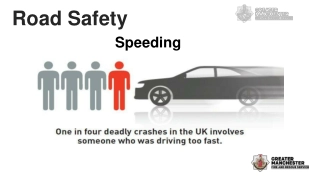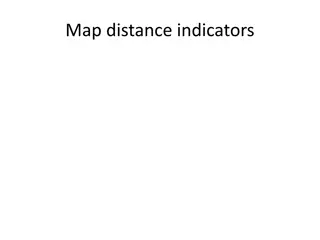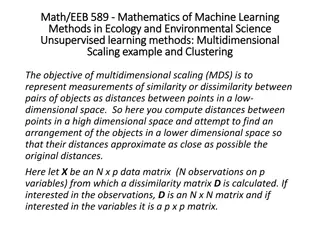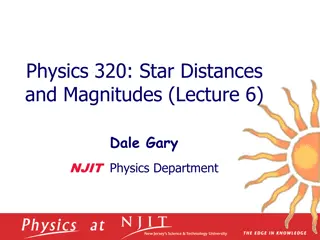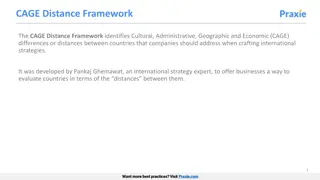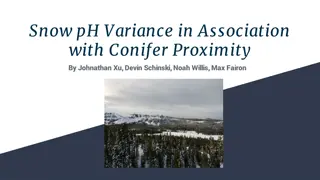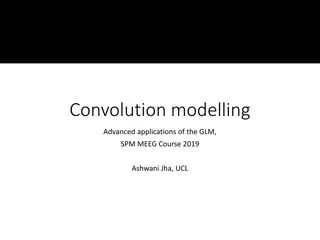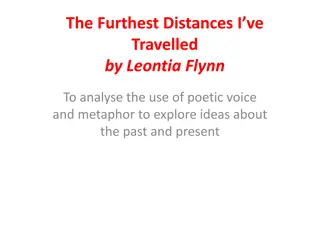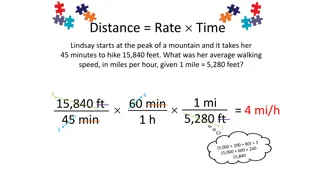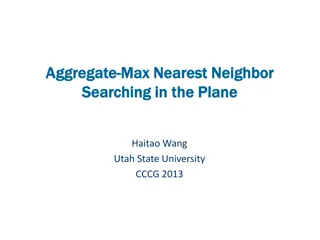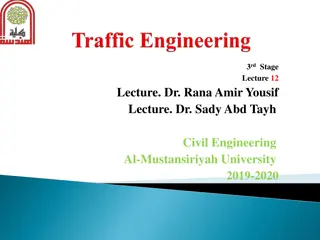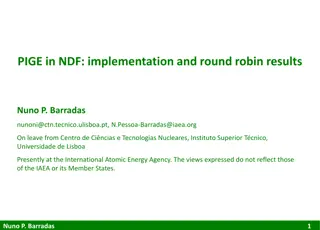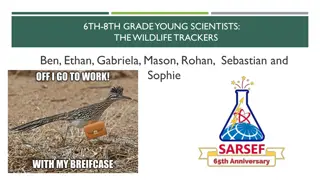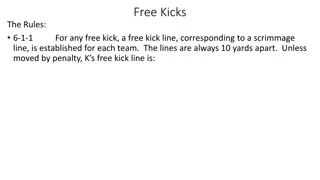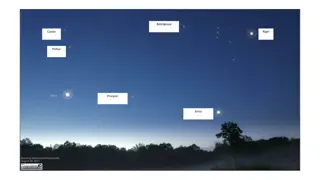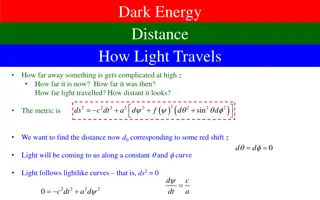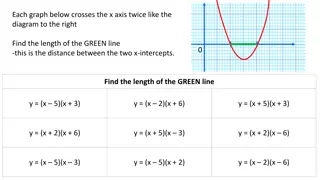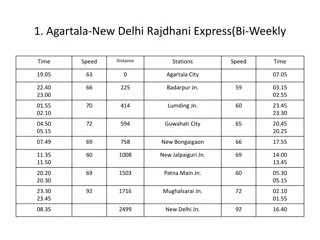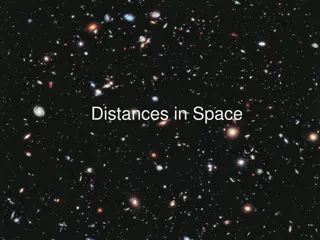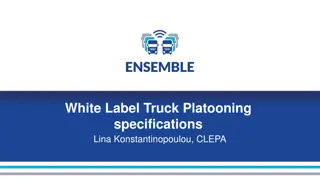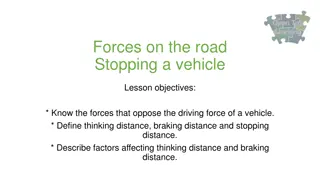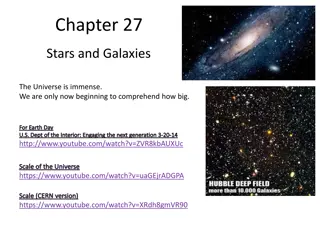Road Safety: Speeding
The dangers of speeding and why it's important to obey speed limits. Discover the impact of speed on stopping distances and the risks posed by rural roads. Follow the Two-Second Rule to maintain a safe following distance. Driving at a safe speed saves lives.
0 views • 12 slides
Young’s double slit
Explore various examples and whiteboard problems related to Young's double slit experiment, diffraction patterns, and interference of light waves. From calculating fringe distances to determining wavelengths and frequencies of light, these examples provide a comprehensive overview of optical phenome
5 views • 30 slides
Railway Safety Awareness Quiz for a Safe Journey
Test your knowledge on railway safety with a series of questions covering topics like crossing railway tracks, train weights, stopping distances, level crossings, electricity hazards, and train speeds. Stay informed to stay safe on your next journey!
0 views • 19 slides
Understanding Distance Indicators and Travel Time Estimation
Distance indicators are used on maps to show distances between locations, aiding in journey planning. Travel time estimation rules help calculate journey durations based on average speeds and external factors. Distance tables assist tourists in determining distances between cities. Learn how to use
0 views • 9 slides
Understanding Multidimensional Scaling and Unsupervised Learning Methods
Multidimensional scaling (MDS) aims to represent similarity or dissimilarity measurements between objects as distances in a lower-dimensional space. Principal Coordinates Analysis (PCoA) and other unsupervised learning methods like PCA are used to preserve distances between observations in multivari
2 views • 21 slides
Road Safety Awareness: Speed and Stopping Distances
Understanding the impact of speed on safe driving, predicting stopping distances, and factors affecting them are crucial elements in road safety. Speeding increases the force of impact during a crash, leading to more severe injuries. Maintaining proper stopping distances, following the two-second ru
0 views • 14 slides
Understanding Motion and Measurement of Distances in Science at Sainik School Gopalganj
Explore the concepts of motion and measurement of distances in science as taught by Dr. A.K. Choubey at Sainik School Gopalganj. Discover the development of means of transport, different measurement methods like non-standard and standard measures, the significance of measurement, and the Internation
1 views • 16 slides
Geometric Design of Highway Vertical Curves and Criteria
This content covers the vertical alignment in transportation engineering, focusing on the geometric design of highway facilities, specifically vertical curves like crest and sag curves. It explains the main design criteria for vertical curves, including minimum stopping sight distance provision, dra
2 views • 24 slides
Understanding Stellar Distances and Brightness in Astronomy
Exploring the methods used in astronomy to determine star distances, from stellar parallax to advanced measurements with spacecraft like Gaia. Delve into the magnitude scale and the concept of apparent magnitude in measuring star brightness.
3 views • 13 slides
Understanding the CAGE Distance Framework for International Business
The CAGE Distance Framework, developed by Pankaj Ghemawat, helps companies assess Cultural, Administrative, Geographic, and Economic distances between countries when crafting international strategies. By considering these factors, businesses can identify implications for their strategy and project.
0 views • 4 slides
Understanding Electronic Distance Measurement in Surveying
Electronic Distance Measurement (EDM) is a precise method for measuring distances between two points using electromagnetic waves. It offers speed and accuracy, especially useful for long or inaccessible distances. EDM, a type of surveying instrument, measures phase changes in energy waves traveling
0 views • 7 slides
Cryogenic Gas Stopping Cell for High Precision Nuclear Physics Experiments
In the field of nuclear physics, high-quality ion beam parameters are essential for both primary and secondary beams. This report focuses on the cryogenic gas stopping cell, also known as a gas catcher, designed to transform rare ion beams from nuclear reactions into low-energy beams with small emit
1 views • 12 slides
Computing Triplet and Quartet Distances Between Evolutionary Trees
Study on computing triplet and quartet distances in evolutionary trees, comparing rooted vs. unrooted, binary vs. arbitrary degree trees. Discusses algorithms, experimental results, and evolutionary tree construction methods. Includes analysis on cultural phylogenetics and evolutionary tree comparis
0 views • 27 slides
Proposal to Extend RIFS in IEEE Std. 802.15.3d/e for Longer Transmission Distances
This document outlines the necessary modifications to extend the Retransmission Interframe Space (RIFS) in IEEE Std. 802.15.3d/e to accommodate larger transmission distances, particularly in backhaul applications. The proposal suggests increasing RIFS by a factor of 10 and introducing new formulas f
0 views • 7 slides
Ice Hockey Training Drills for Skaters
Engage in a variety of ice hockey training drills focusing on skills like crossovers, tight turns, backward skating, puck control, stopping, and battles. Stations incorporate different techniques such as weaving around cones, stopping at specific points, transitioning between forward and backward sk
0 views • 14 slides
Investigating the Influence of Wing Design on Paper Airplane Flight Distances
Exploring how the design of paper airplane wings affects the distance they can fly by analyzing forces such as thrust, lift, drag, and gravity. The study includes data from different paper airplane designs and their flight distances, leading to insights on how wing size impacts flight performance.
0 views • 11 slides
Snow pH Variance in Relation to Conifer Proximity Study
Investigating the impact of conifer proximity on snow pH and melting rates, this study hypothesized that closer proximity to trees would result in lower pH levels and slower melting. By analyzing snow samples from varying distances around conifer trees and conducting experiments, the study confirmed
0 views • 11 slides
Advanced Applications of Convolution Modelling in GLM and SPM MEEG Course 2019
Addressing difficulties in experimental design such as baseline correction, temporally overlapping neural responses, and systematic differences in response timings using a convolution GLM, similar to first-level fMRI analysis. The course focuses on the stop-signal task, EEG correlates of stopping a
0 views • 21 slides
Analyzing Leontia Flynn's Use of Metaphor in "The Furthest Distances I've Travelled
Explore Leontia Flynn's poem "The Furthest Distances I've Travelled" to understand how she employs poetic voice, metaphor, and structure to delve into themes of past and present experiences. Analyze the changes in the narrator's life, the impact of rhyme and enjambment, and the symbolic souvenirs th
0 views • 9 slides
Distance, Rate, Time in Motion Problems Explained
Solving distance, rate, time problems involving hiking speeds, biking distances, and travel times. Learn how to calculate average walking speeds, total distances traveled in given time durations, and time differences between varying travel rates.
0 views • 4 slides
Proposal to Remove Donation Service Areas in Thoracic Organ Transplantation
The proposal aims to ensure compliance with regulations by eliminating Donation Service Areas (DSAs) in thoracic organ allocation policies. The suggested solutions involve replacing DSAs with a 250 NM distance from the donor hospital, removing language allowing prioritization of sensitize heart cand
0 views • 10 slides
Understanding Latitude and Angular Distance on Earth
This content explains the concepts of latitude, angular distance, and distances on Earth using images and descriptions. It covers topics such as North Pole latitude, parallels of latitude, angular distance calculations, nautical miles, and great circle distances. Explore how these concepts relate to
0 views • 12 slides
Searching for Nearest Neighbors and Aggregate Distances in Plane Algorithms
This overview discusses different algorithms related to nearest neighbor searching and aggregate distances in the plane. It covers concepts like aggregate-max, group nearest neighbor searching, applications in meeting location optimization, and previous heuristic algorithm work. Results include prep
0 views • 25 slides
Fascinating Insights into Stellar Distances and Parallax Measurements
Delve into the vast distances between stars, such as Alpha Centauri and Proxima Centauri, captured through intriguing images. Explore the concept of parallax and its role in estimating stellar distances relative to our Sun. Understand the challenges astronomers face in measuring these immense distan
0 views • 7 slides
Distances and Astronomical Bodies in Our Solar System and Beyond
Earth's natural satellite, the Moon, plays a crucial role in shaping life on our planet. Various distances in space, from geostationary orbit to Andromeda Galaxy, hold significance for understanding space exploration and cosmic phenomena.
0 views • 4 slides
Understanding Sight Distance and Stopping Sight Distance in Traffic Engineering
Sight distance is crucial for drivers to spot obstacles and pass safely on highways. Stopping Sight Distance (SSD) is the minimum distance required for a vehicle to stop before reaching a stationary object. Factors affecting SSD include reaction time, speed, and road conditions. Passing Sight Distan
0 views • 15 slides
Principles and Implementation of PIGE in NDF by Nuno P. Barradas
Overview of the basic principles and implementation details of Particle Induced Gamma-ray Emission (PIGE) calculation using NDF code, including handling of stopping power, cross-sections, and sub-layers. The process involves simulating incident energy on each layer, calculating cross-sections, and i
0 views • 23 slides
Understanding the Physics of Yellow Change Interval at ITE International Convention
Delve into the intricate details of the physics behind the yellow change interval at the ITE International Convention. Explore the critical points, braking points, comfortable stopping distances, and the concept of unimpeded through movements. Learn about the equation for turning vehicles decelerati
0 views • 14 slides
Young Scientists Investigate Wildlife Behavior and Habitat Effects
The Wildlife Trackers, a group of young scientists, conducted a study to understand how the presence of people and different habitats affect the behavior and flight responses of animals in their neighborhood. By measuring flight response distances of various animals like birds, lizards, and rabbits,
0 views • 11 slides
Understanding Free Kicks in Football
The rules of free kicks in football define specific lines and distances for each team, such as the 6-1-1 line and the 40-yard line for a kickoff. Various scenarios like safety and fair catch determine the placement of the free kick line. Additionally, specific formation requirements, including playe
0 views • 33 slides
USSSA Softball Rules and Regulations for 2023
In USSSA softball for 2023, there are specific rules regarding pitching distances, base distances, batters' boxes, equipment requirements, and player positions. The rules cover aspects such as pitching distances for different age groups, base distances, coach attire, fair balls, and more. It is impo
0 views • 105 slides
Understanding Stellar Brightness and Magnitude Distances
Explore the relationship between a star's brightness as observed from Earth and its actual brightness, distance, apparent magnitude, and absolute magnitude. Learn how to calculate these values using data and formulas. Gain insights into the variations in star distances, brightness, and magnitudes to
0 views • 6 slides
Understanding Dark Energy and Luminosity Distance in Cosmology
Exploring the concepts of dark energy, luminosity distance, and how light travels through the universe at varying distances and redshifts. The formula and implications of distance measurements using Hubble's Law and luminosity distances are discussed, along with the impact of matter presence, univer
0 views • 15 slides
Mathematical Problems Involving Graphs and Equations
The content includes a set of mathematical problems related to graphs, equations, and modeling of paths using given equations. These problems involve finding distances, heights, and intersection points based on the provided graph representations. The scenarios involve water sprinklers watering lawns
0 views • 6 slides
High-Speed Rajdhani Express Train Routes Across India
Explore the routes of various Rajdhani Express trains connecting prominent cities in India such as Agartala, New Delhi, Silchar, Bangalore, Itanagar, and Nizamuddin. Discover the distances covered, travel times, speeds, and stations along the way. Rajdhani Express trains offer a convenient and effic
0 views • 6 slides
Understanding Distances in Space
Exploring the vast distances in space through units like the Astronomical Unit (AU), Light Year (LY), and Parsecs, and understanding the intricacies of measuring these distances via the Distance Ladder. Delve into the fascinating world of cosmic scales and the uncertainty involved in determining dis
0 views • 54 slides
Overview of White Label Truck Platooning Specifications
White Label Truck Platooning involves driving trucks at short inter-vehicle distances for extended periods, creating a system of interconnected systems with specific requirements. The driver cannot be solely responsible for immediate intervention during critical events, necessitating a unique automa
0 views • 8 slides
Understanding Forces and Stopping Distances in Vehicle Safety
Explore the forces that oppose vehicle motion, and learn about thinking distance, braking distance, and stopping distance. Discover how factors affect these distances, such as friction and reaction time. Gain insights into how friction helps in braking systems and the impact of accelerating or braki
0 views • 16 slides
Exploring the Vast Universe: Stars, Galaxies, and Beyond
Delve into the immense scale of the universe as we uncover the characteristics of stars, their compositions, temperatures, and distances from Earth. Learn how spectroscopy reveals the elements within stars, discover mnemonic devices for remembering star temperatures, and explore methods such as para
0 views • 10 slides
IRIS December Bi-Monthly Meeting: General Comments on Stopping Rules and Research Opportunities
General comments were made at the IRIS December Bi-Monthly Meeting regarding the Stopping Rules document and research opportunities for NCEA to enhance the quality of assessments. Concerns were raised about the restrictions on published/unpublished research and the potential misinterpretations of th
0 views • 12 slides
